There are so many regulations relating to hazardous materials, and they are subject to such regular amendment, that they cannot be dealt with in this Handbook. This section will merely point out a few of the problems relating to these goods.
The general introduction to the IMDG Code gives important information about packaging. Good packaging is half the battle when it comes to cargo securing. Correct packaging should be the norm, but sadly is the exception.
 |
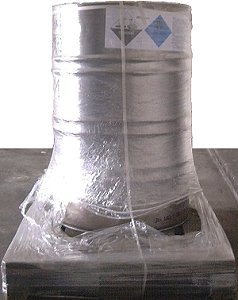 |
Drum for hazardous materials, containing a corrosive substance, which evolves flammable gases on contact with water. |
 |
[N.B.: The drum itself, filling level and labeling would warrant a green light. However, the attempt to form a cargo unit warrants the red light.]
"Rule 3 - Packaging" of the general introduction states, among other things:
| 1 |
Dangerous goods should |
| |
1 be carefully packaged and in good condition; |
| |
2 be of a nature such that internal surfaces with which the contents can come into contact cannot be subjected to dangerous attack, and |
| |
3 be resistant to the stresses produced in handling and transport at sea. |
| 3 |
Receptacles which are filled with dangerous liquids should, at the filling temperature, have a liquid-free volume which makes sufficient allowance for the highest temperature occurring during normal carriage. |
7.3.3 Markings on shipping packages containing dangerous goods must be applied in such a manner that the markings are still discernible on shipping packages which have spent at least three months in seawater. When considering suitable marking methods, the durability of the packaging material and the surface of the shipping package should be taken into account.
 |
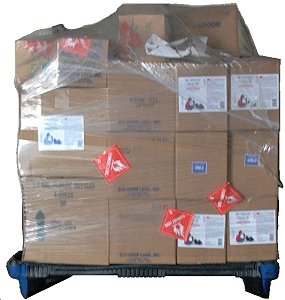 |
Non-regulation cargo unit |
| 10.18.2 packages that contain hazardous goods, that are permitted to be transported in accordance with the code, may only be transported in unit loads if the following conditions are fulfilled.
|
| |
10.18.2.1 It may occur that the packages in a unit load will need to be separated. In this event, it must be ensured that the individual packages can be handled safely. |
| |
10.18.2.2 The unit loads should be compact, have as regular a form as possible, and for the most part, vertical sides. The top of the unit load should be level. It must be possible to stack the unit loads. They must be constructed and secured in such a way that it is unlikely that the individual packages can become damaged. |
| |
10.18.2.3 The unit loads must be sufficiently strong to withstand repeated loading and stowing operations and they must be able to bear unit loads with a similar specific mass which are stacked on them to a height commonly occurring during transportation. |
| |
10.18.2.4 The material used to bind a unit load together must be compatible with the substances contained in the unit loads and must remain effective under the influence of moisture, extreme ambient temperatures and sunlight.
|
| 10.18.3 The individual shipping packages and the unit load must be marked in accordance with sections 7 and 8 of the general introduction.
|
| 10.18.4 Unit loads must be directly liftable with a forklift truck or other suitable equipment. Unless generally visible, lifting points must be marked on the unit load. |
The CTU packing guidelines contain, among other things, the following regulations:
4.2.5 Dangerous cargoes should only be handled, packed and secured under direct and identifiable supervision of a responsible person who is familiar with the legal requirements and the risks involved and who knows the measures that should be taken in an emergency.
4.2.6 Suitable measures to prevent fires should be taken, including the prohibition of smoking in the vicinity of dangerous cargoes.
3.2.7 In order to avoid cargo damage from moisture, wet cargoes, moisture-inherent cargoes or cargoes liable to leak should not be packed with cargoes susceptible to damage by moisture. Wet dunnage, pallets or packaging should not be used. In certain cases, damage to equipment and cargo can be prevented by the use of protective material such as plastic films.
 |
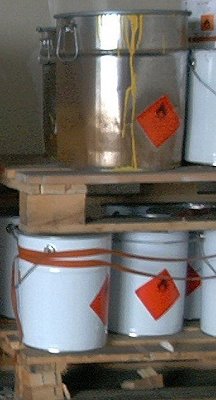 |
Damaged bucket - non-regulation cargo unit |
3.2.8 Damaged packages should not be packed into CTUs unless precautions have been taken against harm from spillage or leakage (see 4.2.7 and 4.3.1 for dangerous cargoes).
4.3.1 Special care should be taken during handling to avoid damage to packages. However, if a package containing dangerous cargoes is damaged during handling so that the contents leak out, the immediate area should be evacuated until the hazard potential can be assessed. The damaged package should not be shipped. It should be moved to a safe place in accordance with instructions given by a responsible person who is familiar with the risks involved and knows the measures that should be taken in an emergency.
 |
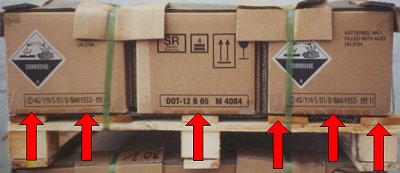 |
| |
Dangerous cargo with traces of liquid |
4.2.7 Packages of dangerous cargoes should be examined and any found to be damaged, leaking or sifting should not be packed into a CTU. Packages showing evidence of staining etc. should not be packed without first determining that it is safe and acceptable to do so. Water, snow, ice or other matter adhering to packages should be removed before packing. Liquids that have accumulated on drum heads should initially be treated with caution in case they are the result of leakage of contents. If pallets have been contaminated by spilt dangerous cargoes they should be destroyed by appropriate disposal methods to prevent use at a later date.
 |
 |
Non-regulation cargo unit |
4.2.8 If dangerous cargoes are palletized or otherwise unitized they should be compacted so as to be regularly shaped, with approximately vertical sides and level at the top. They should be secured in a manner unlikely to damage the individual packages comprising the unit load. The materials used to bond a unit load together should be compatible with the substances unitized and retain their efficiency when exposed to moisture, extremes of temperatures and sunlight.
4.2.9 The packing and method of securing of dangerous cargoes in a CTU should be planned before packing is started.
 |
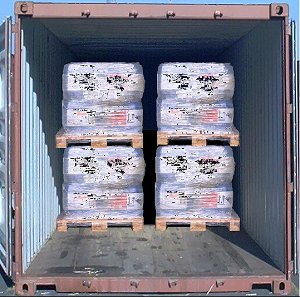 |
How well was
this planned? |
Nothing good ever comes of gaps in a container, especially not if no interlayer dunnage is used.
The result of such packing methods may look like this:
 |
 |
 |
| |
Consequence of stowage gaps in containers |
The Container Packing Certificate must, among other things, confirm correct packing behavior. This states:
All packaged have been externally inspected for damage, and only sound packages have been loaded.
4.3.2 If a leakage of dangerous cargoes presents safety or health hazards such as explosion, spontaneous combustion, poisoning or similar danger, personnel should immediately be moved to a safe place and the Emergency Response Organization notified
4.3.3 Dangerous cargoes should not be packed in the same CTU with incompatible cargoes. In some instances even cargoes of the same class are incompatible with each other and should not be packed in the same unit. The requirements of the IMDG Code concerning the segregation of dangerous cargoes inside CTUs are usually more stringent than those for road and rail transport. Whenever a combined transport operation does not include transport by sea, compliance with the respective inland transport regulations, such as ADR, RID, ADN and ADNR, may be sufficient. However, if it cannot be guaranteed that no part of the transport operation will be by sea, the segregation requirements of the IMDG Code should be strictly complied with.
4.3.4 When dangerous cargoes are being handled, the consumption of food and drink should be prohibited.
3.2.11 Any special instructions on packages, or otherwise available, should be followed, e.g.:
|
| - |
cargoes marked "protect from frost" should be packed away from the walls of a CTU;
|
| - |
cargoes marked "this way up" should be packed accordingly;
|
| - |
maximum stacking height marked should not be exceeded; and
|
| where practicable, markings on packagings should conform to ISO 780-1983. |
|







